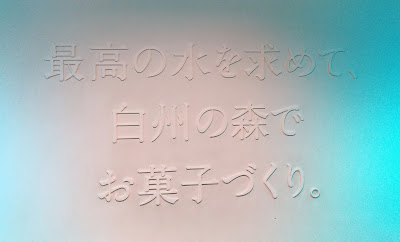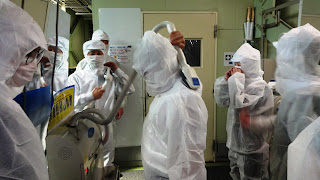
Châteraisé is a household name for most Japanese. With more than 500 stores scattered throughout the country and even branches located in countries abroad such as China, Indonesia, and Taiwain, the company has been producing traditional Japanese as well as Western-style sweets for over 60 years.
 Founded in Kofu City in 1954 as a confectionery shop specializing in imagawayaki (a kind of dumpling made with wheat and stuffed with sweet azuki bean paste), Châteraisé soon became a success and was able to open a network of stores around Yamanashi. However, its nationwide success came with the industrialized production of Western-style sweets in the mid-1960s, when the company began selling cream puffs (choux-cream) for only 10 yen whereas most other companies still focused on manual production of the same treat for around 50 yen.
Founded in Kofu City in 1954 as a confectionery shop specializing in imagawayaki (a kind of dumpling made with wheat and stuffed with sweet azuki bean paste), Châteraisé soon became a success and was able to open a network of stores around Yamanashi. However, its nationwide success came with the industrialized production of Western-style sweets in the mid-1960s, when the company began selling cream puffs (choux-cream) for only 10 yen whereas most other companies still focused on manual production of the same treat for around 50 yen.Châteraisé is committed to producing high quality, fair price sweets and candies using as few additives as possible so that all products are fresh when consumed. For this to be possible, the company has a unique system of production and delivery, starting with choosing ingredients and suppliers, distributing the finished product on its own, and selling it only in stores within its network.
The company's main three factories are all located in Yamanashi: Hakushu, Nakamichi, and Toyotomi, and each specialize in one type of production. Our colleagues have visited the Toyotomi factory in the past, which produces cakes and cream puffs (see more here), but this time we visited the Hakushu factory in Hokuto City, which is responsible for the production of ice cream.
As with its other factories, all the ingredients that arrive in Hakushu come from contracted farms, guaranteeing quality control and freshness as the ingredients are delivered directly. A special feature of the Hakushu factory is its water: the Hakushu region is famous for its pure water, which runs from the mountains of the Minami Alps and is the water used in the factory to produce ice cream as well as kakigori (a kind of shaved ice, popular in the summer) and adzuki sweet bean paste. Since Hakushu water is essential for producing a high quality bean jam, Hakushu factory is the only one to produce the adzuki paste used in Châteraisé sweets.

| 最高の水を求めて、白州の森でお菓子づくり。 |
 However, we had the opportunity to see operations up close, and in order to do so we had to go through a number of safety and hygienic procedures. Special clothing, face masks and hair nets, vacuuming, wind showers ... the amount of procedures and the rigidity of the hygienic standards impressed us and we learned that all this care is necessary to ensure the quality of the product and customer safety.
However, we had the opportunity to see operations up close, and in order to do so we had to go through a number of safety and hygienic procedures. Special clothing, face masks and hair nets, vacuuming, wind showers ... the amount of procedures and the rigidity of the hygienic standards impressed us and we learned that all this care is necessary to ensure the quality of the product and customer safety.Starting at the ice cream production line, we learned how to make the Choco Bucky ice cream, a vanilla ice cream filled with a generous amount of chocolate. Recently re-vamped with new flavors, this ice cream is Hakushu's big bet for this year.
We also saw how macaroons stuffed with ice cream are produced - and tasted them (!) - and saw how cakes are decorated, transported, and packaged on the product line, which is almost completely automated. Finally, we also learned about the production of adzuki bean paste.

 Châteraisé is famous among Brazilians in Japan not just for their sweets. Yamanashi Prefecture has a population of approximately 1,600 Brazilians and the three main Châteraisé factories employ many of them, so I was not surprised to see many posters and guidelines throughout the factory written in Portuguese!
Châteraisé is famous among Brazilians in Japan not just for their sweets. Yamanashi Prefecture has a population of approximately 1,600 Brazilians and the three main Châteraisé factories employ many of them, so I was not surprised to see many posters and guidelines throughout the factory written in Portuguese! At the end of the tour, visitors can refresh themselves with water from Hakushu and, of course, ice cream produced at the factory for free.
At the end of the tour, visitors can refresh themselves with water from Hakushu and, of course, ice cream produced at the factory for free.
One of the major differences between Châteraisé ice cream and that of other companies is that, although not required by law, all Châteraisé ice cream includes an expiration date. This is to indicate how long the product can be consumed without any change in quality, and it shows Châteraisé's dedication to production high quality sweets using high quality ingredients.
https://www.chateraise.co.jp/global
More information on guided tours of factory:
https://www.chateraise.co.jp/enjoy/factory_tour




No comments:
Post a Comment